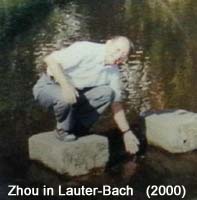Figure 2
 ..........................MICROSCALE
CHEMISTRY
..........................MICROSCALE
CHEMISTRY
The 21th century calls for
creativity. We believe that the people’s ability to handle challenges and
to push the society forward lies in how their creativity is motivated and
inspired. Chinese president Mr. Jiang Zeming said: Innovation is a nation’s
soul and a country’s limitless impetus of prosperity and development. So
we shall put more emphasis on creativity in different levels of education.
According to recent surveys and reviews teachers as well as government
officials in China realized that students’ curiosity and creativity have
been strangled by traditional education. Recently, the International Evaluation
Organization of Education Progress has investigated the students’ creative
ability in 21 countries. The result of the investigation shows
that Chinese students’ creativity ranks 16th position in 21 countries.
Only 4.7% students in primary or middle school think they have creativity.14.9%
students want to be educated with curiosity and creativity. This is a very
serious situation. It means that reforms are needed in tradition educational
system. The Chinese Minister of Education, recently, promulgated a new
curriculum plan for senior high school. In the plan, there is new required
course:
Comprehensive Practical
Activities, 9 hrs per week
The main content in this
course is Inquiry Based Instruction. This is learning from western countries.
The purpose of this course is to inspire students’ creative thinking and
implement the practicing ability by learning problem-solving methods. Microscale
chemistry (or microscale laboratory is abbreviated to M.L. in China) plays
a significant role not only in the study of chemistry, but also in cultivation
with creativity.
Up to now, Chinese students
have few chances to do hand-on experiment themselves. Because traditional
education pays little attention to practice and the lack of funds…..…..
……. Another creative example is a set of apparatus for microscale preparation and series reactions of chlorine (Figure 2). It is constructed by the lids with two conduct pipes (input and output), syringe and 6 holes well plate. There is 1g KMnO4 in well 1#, when the concentrated hydrochloric acid drops in the well through syringe, chlorine is generated. There is wet color test paper in well 2#, when chlorine conducts in this well, test paper discolors. Well 3# has concentrated sulfuric acid. Well 4# has dry color test paper. Dry chlorine cannot decolorize dry test paper. There is potassium bromide solution in well 5#. When chlorine is conducted through this well, the colorless solution changes brown, which shows bromine was formed. If there is 30% KOH solution in well 6# and the whole plate is heated in a water bath, chlorine conducted through this well causes a reaction and a crystal of potassium chlorate is produced. The remaining chlorine was absorbed by the sodium hydroxide solution in the other well plate. This experiment shows the series main reactions of chorine but no chorine given off. This apparatus is easily suited similar gases preparation and series reactions.
One disadvantage of this plastic apparatus is that it can’t heat by alcohol burner. To solve this problem, we connect glass apparatus, which can be heated. A set apparatus for microscale synthesis of SnCl4 was shown in Figure 3. Since Tin Tetrachloride is easily hydrolysed, the first well plate (A) was uses as dry Cl2 generator. Second plate (B) was used to absorb rest Cl2. Adopt this set apparatus, using 1g KMnO4, 3mL concentrated HCl and 60mg Tin, we got 0.4g SnCl4. When students hand-on such experiments, the image thinking and creativity were cultivated.
Figure 3
1# .KMnO4 2#.suffer container
3#.saturatedNaCl 4#.concentrated H2SO4?A?
5#.suffer container
6#.concentrated H2SO47#.suffer container
8#.6mol/LNaOH ?B?
9#. Sn in the glasstube 10#. 10mL test tube with arm
There is a question in chemical lab manual of junior high school in China, how can you identify the main content of egg-shell? Normally students give the answer that the reaction of diluted hydrochloric acid with egg-shell produces carbon dioxide bubbles showing that the main content of egg-shell is carbonate. A student of Anji Third middle school, Zhejiang province designed an apparatus (Figure 4) by cutting a pipette and using the well plate. He succeeded in identifying the content of egg’s shell by this apparatus and felt very happy. When I heard this story, I was excited. It shows our student’s creativity is inspired by microscale lab.
Reference
[1]. N.H.Zhou, Microscale
Inorganic Chemistry, Science Press, 2000, Beijing
[2].N.H.Zhou, X.Y.Tu, Chemistry
online, 2001.12
[3].Y.Q.Zhu, N.H.Zhou, Chemical
Activities and Microscale Laboratory, The Democracy and Construction Press,
1999, Beijing